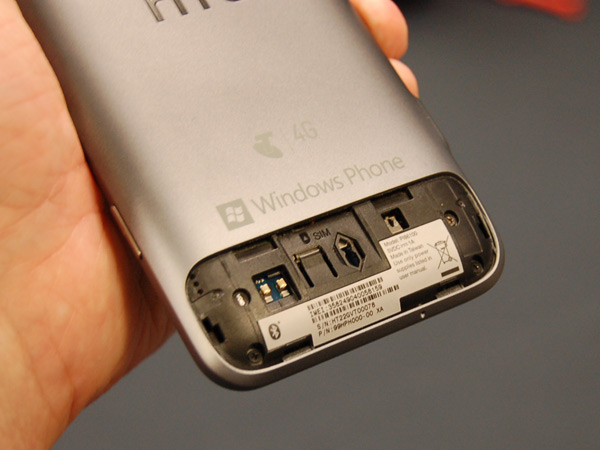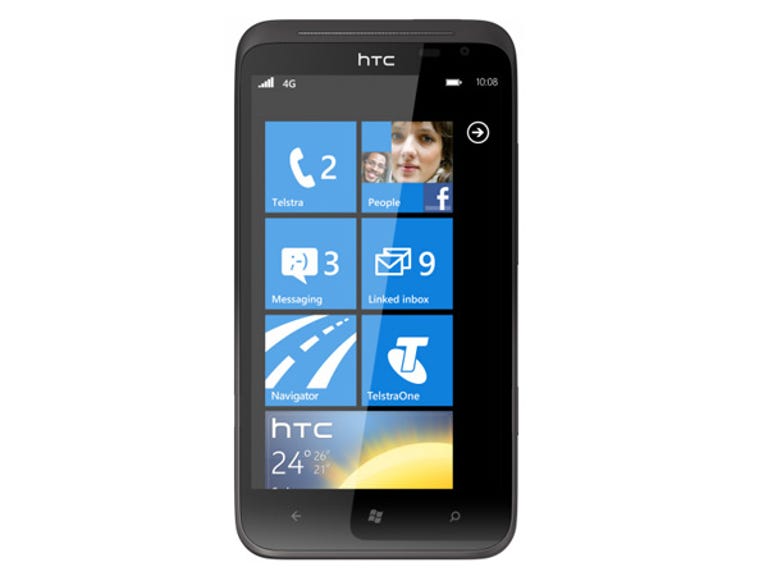 Why You Can Trust CNET
Why You Can Trust CNET HTC Titan 4G review: HTC Titan 4G
The Titan 4G lives up to its name in many respects, and offers the same clean, fast Windows Phone experience we've become accustomed to. It's also held back by the same Windows woes.
Design
HTC is taking the Titan to where no Windows Phone has gone before. With a 4.7-inch LCD display, the Titan lives up to its name, with heavyweight proportions to match its epic title. It's not just the size of its screen, though; the Titan 4G handset is a monster, compared with its Android-based stable mates, the One X and One XL. Though it shares a similar height and width, the Titan is thicker and feels heavier than the One-Series phones.
The Good
The Bad
The Bottom Line
Also, like the Androids, the Titan 4G features a non-user-replaceable battery and no micro-SD card slot to expand its 16GB of internal storage; the latter being a restriction of the Windows Phone OS, and not a decision made by HTC. This storage is shared between system apps, too, so the user gets just under 12GB for saving personal data, music and app downloads. You can sync photos and documents to Microsoft's SkyDrive service, and retrieve them quickly when you want them, but cloud storage is still far less popular than having on-board memory.

Under the trap door: only the micro SIM is user accessible.
(Credit: CBSi)
The handset's 4.7-inch display is a highlight, with plenty of screen real estate for web browsing, emailing and gaming. HTC chooses a Super LCD panel for this display, which offers nice, warm colours and good viewing angles. It is substantially lower resolution than the same-sized screen on the One X — again, a limitation of Windows Phone — but this hasn't bothered us too much, thanks to the clean user interface design of the operating system.
Compared to
| HTC Titan 4G 800x480 pixels | Nokia Lumia 900 800x480 pixels | Samsung Galaxy S2 4G 800x480 pixels | Apple iPhone 4S 960x640 pixels |
| 4.7-inch Super LCD 800x480 pixels | 4.3-inch AMOLED 800x480 pixels | 4.5-inch AMOLED 800x480 pixels | 3.5-inch IPS LCD 960x640 pixels |
| 1.5GHz processor | 1.4GHz processor | 1.5GHz dual-core processor | 1GHz dual-core processor |
| Windows Phone 7.5 | Windows Phone 7.5 | Android 2.3 | iOS 5.1 |
| 16GB storage | 16GB storage | 16GB storage plus microSD expansion | 16GB, 32GB and 64GB storage options |
| 16-megapixel Dual-LED flash | 8-megapixel LED flash | 8-megapixel LED flash | 8-megapixel LED flash |
User experience and performance
If you've seen any of the recent Nokia Windows Phone releases, then you've seen the Titan 4G, for all intents and purposes. Microsoft maintains a tight leash on OEMs developing Windows Phone products, and, as such, there is limited variation between them. This doesn't us offer us a lot to write about without repetition, but it is a good approach in many respects. The Windows Phone system offers an often flawless experience, with slick, fast navigation and zippy application load times. Multitasking is top notch, and the system offers excellent email and contacts management with deep Facebook integration.
HTC does offer a few unique tweaks to the platform, where it can. This is the first HTC Windows Phone to include the HTC Watch movie-streaming app, for example. Watch has been on Android phones for some time, and it offers a movie-rental service for those who want to watch the latest releases on their smartphone. It is also the first Windows Phone handset we've seen to offer an internet sharing feature, which lets you create a Wi-Fi hotspot to share your 3G or 4G data with up to five other devices simultaneously. Apparently, the Nokia 900 will also feature this service, but the Titan 4G still takes the ribbon for first.
It's lucky that the Titan features internet sharing, too; otherwise, the inclusion of 4G data speeds would have been somewhat wasted. This is the first 4G Windows Phone, and, with the way the system is designed, there is very little use for fast data speeds in everyday use. Microsoft's Windows Phone team has done a fine job of building apps with low data-usage requirements, so it is difficult to see how much this phone benefits from the extra speed. The Internet Explorer web browser is a good example of an app built with speed in mind — but, to achieve this, Microsoft has avoided many of the web standards that make the internet interesting to look at. By default, it diverts to mobile versions of pages where possible, it doesn't support Flash content and it has limited success in loading JavaScript elements. For example, if you visit m.cnet.com on an Android phone or the iPhone, you'll find a colourful page with a large image carousel that you can scroll through horizontally with a swiping gesture. But on the Titan 4G, this page is translated into a list of text hyperlinks.
Camera
With our attention being drawn to the large, beautiful screen and 4G speeds, it is easy to overlook the fact that the Titan 4G also represents another smartphone milestone. For this release, HTC has employed a 16-megapixel image sensor in-camera — the first smartphone image sensor of this size to be commercially released. HTC matches this sensor with a dual-LED flash set-up, plus the standard camera software found in Windows Phone.
The camera module on the Titan is quite big, with a massive lens.
(Credit: CBSi)
The results are fantastic, with the Titan 4G capable of capturing pleasing, colourful shots quite quickly. The autofocus is zippy and relatively accurate, and we have been impressed with how similar the final photo is, compared with the image on-screen before the shot was taken. The colours could be a tad bolder, but then, HTC has also installed its Photo Enhancer app for you to play with.
(Credit: CBSi)
(Credit: CBSi)
Windows woes
We alluded to the limitations of Windows Phone in our comments above, but it is worth pointing out a few of the features that you'll forego in choosing Microsoft's platform at this stage of its evolution. The browser is the big one for us: the Internet Explorer (IE) app falls a long way short of the stock Android browser or any of the third-party browsers available through the Google Play store. It is also more limited than the iOS Safari browser, though both Safari and IE avoid Flash content. This accounts for so much of the video online that if a video's source isn't YouTube, there is a good chance that you can't watch it on the Titan 4G.
Multimedia is another area where Windows Phone is stuck in its ways. Out of the box, the Titan 4G can play only a small selection of media file types: MP3, WAV and AAC audio files, and MP4, WMV and H.264 video files. The Zune desktop software can transcode media that you have on your PC into compatible files to play on your phone, but this is extremely time consuming, and it relies on you having the files on a PC with Zune installed.
More problematic than not having out-of-the-box access to these features is the fact that you can't get apps to supplement these areas of the user experience. Microsoft, like Apple, is cautious about which core applications can be augmented with third-party tools. The keyboard is another example. While the Microsoft-designed keyboard is excellent, you don't have the choice to install something else if you prefer.
Overall
If you like your phones thicker and with a bit of heft (and we've heard this from readers on several occasions) then the Titan 4G could be the phone for you. If you weigh up the pros and cons, you'll notice that HTC has delivered on its side of the equation, with good design, a great screen and a first for smartphone imaging. Compared with other popular smartphones, there are a few notable absences, and most of these can be traced back to Windows Phone, and how Microsoft is protecting its platform. There is no memory expansion, there are limitations on screen resolution and the web-browsing and multimedia experience need improvement to compete with the best from the rest.
That said, Apple's iPhone has similar limitations, and millions of Australians have flocked to iOS without complaint. Broadly speaking, Windows Phone offers what iOS offers, with a simple, uncluttered user experience that is perfect for smartphone newbies. Experienced users will hate the lack of customisation available, but, if you want a fast, clean smartphone experience that you don't have to think too much about, then Windows Phone is an excellent choice. If you want to add a 4G data connection into the mix, then the Titan 4G is the only way to go. If you don't care too much for 4G, Nokia will soon have four Windows Phones in Australia, all of which are cheaper, but offer a very similar experience.


